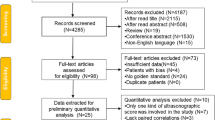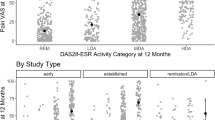Abstract
The reliability and clinical usefulness of the different composite disease activity scores and their individual components in Rheumatoid Arthritis (RA) are still debated. This study investigated which measures of disease activity were preferred by rheumatologists. A mixed-method study was performed. First, ten Belgian rheumatologists were invited for individual interviews on their current practice and preferences for measurement of RA disease activity. Results of this qualitative study and evidence from literature served as input for developing a survey. This survey asked rheumatologists to rate preferred standard disease activity score(s), their individual components, ultrasound and related patient-reported outcomes (PROs), by maximum difference scaling. The relative importance score (RIS) for each indicator was calculated using hierarchical Bayes modeling. The qualitative study included 6/10 invited rheumatologists. Composite scores and components were perceived as useful, while PROs were found subjective. Interestingly, ultrasound was used to mediate discrepancies between physician and patient. The survey based on this was sent to 244 Belgian rheumatologists, 83/244 (34%) responded, including 66/83 (80%) complete and 17/83 (20%) incomplete surveys (two missing essential information). Most rheumatologists (75/81, 93%) used a disease activity score and 68/81 (84%) preferred the DAS28-CRP. Swollen joint count obtained the highest mean ± SD RIS (22.54 ± 2.64), followed by DAS28 ESR/CRP (20.61 ± 4.06), ultrasound (16.47 ± 7.97), CRP (13.34 ± 6.11) and physician’s global assessment (12.59 ± 7.83). PROs including fatigue, pain, and patient’s global assessment, and Health Assessment Questionnaire, obtained the lowest mean RIS (0.34–2.54). Rheumatologists place more faith in self-assessed disease activity components or in laboratory tests. Trust in PROs to evaluate disease activity is low in clinical practice.



Similar content being viewed by others
Availability of data and material
The data source is available upon reasonable request by authors.
Code availability
The survey was constructed and partly analyzed using the Sawtooth Software’s SSI Web platform (version 9.8.1), for which an academic grant was acquired. Additional analyses were performed in Microsoft Excel, Statdisk and VassarStats.
References
Smolen JS, Landewe RBM, Bijlsma JWJ, Burmester GR, Dougados M, Kerschbaumer A et al (2020) EULAR recommendations for the management of rheumatoid arthritis with synthetic and biological disease-modifying antirheumatic drugs:2019 update. Ann Rheum Dis. https://doi.org/10.1136/annrheumdis-2019-216655
England BR, Tiong BK, Bergman MJ, Curtis JR, Kazi S, Mikuls TR et al (2019) Update of the american college of rheumatology recommended rheumatoid arthritis disease activity measures. Arthritis Care Res (Hoboken) 71(12):1540–1555. https://doi.org/10.1002/acr.24042
van der Heijde DM, van’t Hof M, van Riel PL, van de Putte LB (1993) Development of a disease activity score based on judgment in clinical practice by rheumatologists. J Rheumatol 20(3):579–581
Fransen J, Moens HB, Speyer I, van Riel PL (2005) Effectiveness of systematic monitoring of rheumatoid arthritis disease activity in daily practice: a multicentre, cluster randomised controlled trial. Ann Rheum Dis 64(9):1294–1298. https://doi.org/10.1136/ard.2004.030924
Landewe RBM (2018) Overdiagnosis and overtreatment in rheumatology: a little caution is in order. Ann Rheum Dis 77(10):1394–1396. https://doi.org/10.1136/annrheumdis-2018-213700
Boers M (2020) Patient global assessment to define remission in rheumatoid arthritis: quo vadis? Ann Rheum Dis. https://doi.org/10.1136/annrheumdis-2020-218802
Aletaha D, Wang X, Zhong S, Florentinus S, Monastiriakos K, Smolen JS (2020) Differences in disease activity measures in patients with rheumatoid arthritis who achieved DAS, SDAI, or CDAI remission but not Boolean remission. Semin Arthritis Rheum 50(4):643–644. https://doi.org/10.1016/j.semarthrit.2020.03.022
Bray C, Bell LN, Liang H, Haykal R, Kaiksow F, Mazza JJ et al (2016) Erythrocyte sedimentation rate and C-reactive protein measurements and their relevance in clinical medicine. WMJ 115(6):317–321
Keenan RT, Swearingen CJ, Yazici Y (2008) Erythrocyte sedimentation rate and C-reactive protein levels are poorly correlated with clinical measures of disease activity in rheumatoid arthritis, systemic lupus erythematosus and osteoarthritis patients. Clin Exp Rheumatol 26(5):814–819
Kneepkens EL, van den Oever I, Plasencia CH, Pascual-Salcedo D, de Vries A, Hart M et al (2017) Serum tocilizumab trough concentration can be used to monitor systemic IL-6 receptor blockade in patients with rheumatoid arthritis: a prospective observational cohort study. Scand J Rheumatol 46(2):87–94. https://doi.org/10.1080/03009742.2016.1183039
Cheung PP, Gossec L, Mak A, March L (2014) Reliability of joint count assessment in rheumatoid arthritis: a systematic literature review. Semin Arthritis Rheum 43(6):721–729. https://doi.org/10.1016/j.semarthrit.2013.11.003
French T, Hewlett S, Kirwan J, Sanderson T (2013) Different wording of the patient global visual analogue scale (PG-VAS) affects rheumatoid arthritis patients’ scoring and the overall disease activity score (DAS28): a cross-sectional study. Musculoskeletal Care 11(4):229–237. https://doi.org/10.1002/msc.1046
Ferreira RJO, Eugenio G, Ndosi M, Silva C, Medeiros C, Duarte C et al (2018) Influence of the different “patient global assessment” formulations on disease activity score by different indices in rheumatoid arthritis. Clin Rheumatol 37(7):1963–1969. https://doi.org/10.1007/s10067-018-4063-9
Hirsh J, Wood P, Keniston A, Peng M, Ramaswami S, Caplan L et al (2019) Limited health literacy and patient confusion about rheumatoid arthritis patient global assessments and model disease states. Arthritis Care Res (Hoboken) 71(5):611–619. https://doi.org/10.1002/acr.23692
De Cock D, Hirsh J (2020) The rheumatoid arthritis patient global assessment: improve it or lose it! Rheumatology (Oxford) 59(5):923–924. https://doi.org/10.1093/rheumatology/kez566
Ferreira RJO, de Wit M, Henriques M, Pinto AF, Duarte C, Mateus E et al (2020) ‘It can’t be zero!’ difficulties in completing patient global assessment in rheumatoid arthritis: a mixed methods study. Rheumatology (Oxford) 59(5):1137–1147. https://doi.org/10.1093/rheumatology/kez467
Hensor EM, Emery P, Bingham SJ, Conaghan PG, Consortium Y (2010) Discrepancies in categorizing rheumatoid arthritis patients by DAS-28(ESR) and DAS-28(CRP): can they be reduced? Rheumatology (Oxford) 49(8):1521–1529. https://doi.org/10.1093/rheumatology/keq117
Matsui T, Kuga Y, Kaneko A, Nishino J, Eto Y, Chiba N et al (2007) Disease Activity Score 28 (DAS28) using C-reactive protein underestimates disease activity and overestimates EULAR response criteria compared with DAS28 using erythrocyte sedimentation rate in a large observational cohort of rheumatoid arthritis patients in Japan. Ann Rheum Dis 66(9):1221–1226. https://doi.org/10.1136/ard.2006.063834
Ferreira RJO, Welsing PMJ, Jacobs JWG, Gossec L, Ndosi M, Machado PM et al (2020) Revisiting the use of remission criteria for rheumatoid arthritis by excluding patient global assessment: an individual meta-analysis of 5792 patients. Ann Rheum Dis. https://doi.org/10.1136/annrheumdis-2020-217171
Ferreira RJO, Santos E, Gossec L, da Silva JAP (2020) The patient global assessment in RA precludes the majority of patients otherwise in remission to reach this status in clinical practice. Should we continue to ignore this? Semin Arthritis Rheum 50(4):583–585. https://doi.org/10.1016/j.semarthrit.2020.03.014
Dierckx de Casterle B, Gastmans C, Bryon E, Denier Y (2020) QUAGOL: a guide for qualitative data analysis. Int J Nurs Stud 49(3):360–371. https://doi.org/10.1016/j.ijnurstu.2011.09.012
Spijk-de Jonge MJ, Weijers JM, Boerboom LWM, Huis AMP, Atsma F, Van Hulst LTC et al (2020) Disease activity-based management of rheumatoid arthritis in Dutch daily clinical practice has improved over the past decade. Clin Rheumatol 39(4):1131–1139. https://doi.org/10.1007/s10067-019-04913-7
Taylor A, Bagga H (2011) Measures of rheumatoid arthritis disease activity in Australian clinical practice. ISRN Rheumatol 2011:437281. https://doi.org/10.5402/2011/437281
Curtis JR, Chen L, Danila MI, Saag KG, Parham KL, Cush JJ (2018) Routine use of quantitative disease activity measurements among US rheumatologists: implications for treat-to-target management strategies in rheumatoid arthritis. J Rheumatol 45(1):40–44. https://doi.org/10.3899/jrheum.170548
Yu Z, Lu B, Agosti J, Bitton A, Corrigan C, Fraenkel L et al (2018) Implementation of treat-to-target for rheumatoid arthritis in the US: analysis of baseline data from a randomized controlled trial. Arthritis Care Res (Hoboken) 70(5):801–806. https://doi.org/10.1002/acr.23343
Gazitt T, Oren S, Reitblat T, Lidar M, Gurman AB, Rosner I et al (2019) Treat-to-target concept implementation for evaluating rheumatoid arthritis patients in daily practice. Eur J Rheumatol 6(3):136–141. https://doi.org/10.5152/eurjrheum.2019.18195
van Hulst LT, Kievit W, van Bommel R, van Riel PL, Fraenkel L (2011) Rheumatoid arthritis patients and rheumatologists approach the decision to escalate care differently: results of a maximum difference scaling experiment. Arthritis Care Res (Hoboken) 63(10):1407–1414. https://doi.org/10.1002/acr.20551
Studenic P, Radner H, Smolen JS, Aletaha D (2012) Discrepancies between patients and physicians in their perceptions of rheumatoid arthritis disease activity. Arthritis Rheum 64(9):2814–2823. https://doi.org/10.1002/art.34543
Schoemaker CG, de Wit MPT (2020) Treat-to-target from the patient perspective is bowling for a perfect strike. Arthritis Rheumatol. https://doi.org/10.1002/art.41461
Ferreira RJO, Ndosi M, de Wit M, Santos EJF, Duarte C, Jacobs JWG et al (2019) Dual target strategy: a proposal to mitigate the risk of overtreatment and enhance patient satisfaction in rheumatoid arthritis. Ann Rheum Dis 78(10):e109. https://doi.org/10.1136/annrheumdis-2018-214199
Haavardsholm EA, Aga AB, Olsen IC, Lillegraven S, Hammer HB, Uhlig T et al (2016) Ultrasound in management of rheumatoid arthritis: ARCTIC randomised controlled strategy trial. BMJ 354:i4205. https://doi.org/10.1136/bmj.i4205
Meyfroidt S, van Hulst L, De Cock D, Van der Elst K, Joly J, Westhovens R et al (2014) Factors influencing the prescription of intensive combination treatment strategies for early rheumatoid arthritis. Scand J Rheumatol 43(4):265–272. https://doi.org/10.3109/03009742.2013.863382
Gaur PS, Zimba O, Agarwal V, Gupta L (2020) Reporting survey based studies—a primer for authors. J Korean Med Sci 35(45):e398. https://doi.org/10.3346/jkms.2020.35.e398
Pazmino S, Lovik A, Boonen A, De Cock D, Stouten V, Joly J et al (2021) Does including pain, fatigue, and physical function when assessing patients with early rheumatoid arthritis provide a comprehensive picture of disease burden? J Rheumatol 48(2):174–178. https://doi.org/10.3899/jrheum.200758
Lemmey AB, Wilkinson TJ, Clayton RJ, Sheikh F, Whale J, Jones HS et al (2016) Tight control of disease activity fails to improve body composition or physical function in rheumatoid arthritis patients. Rheumatology (Oxford) 55(10):1736–1745. https://doi.org/10.1093/rheumatology/kew243
Acknowledgements
We would like to thank Sawtooth Software, Inc for providing us a student licence to use their software. We would like to thank Catherine Bailleux for her support in contacting the rheumatologists.
Funding
No specific funding for this study was obtained.
Author information
Authors and Affiliations
Contributions
DDC, EB, RW and PV designed the study. DDC and EB drafted the manuscript. All authors supported the analysis of the results, revised the paper critically for important intellectual content; approved the final version of the draft and agreed to be accountable for all aspects of the work.
Corresponding author
Ethics declarations
Conflict of interest
The authors declare that they have no conflict of interest.
Ethics approval
The Ethical Committee of the KU Leuven approved this study (MP011755) on 23/12/2019. Participants had to indicate to have read and accept an information letter before starting this anonymous survey.
Informed consent
Authors reporting on experimental work on humans should, where relevant, submit evidence that the work has been approved by an institutional clinical research panel or its equivalent.
Additional information
Publisher's Note
Springer Nature remains neutral with regard to jurisdictional claims in published maps and institutional affiliations.
Supplementary Information
Below is the link to the electronic supplementary material.
Rights and permissions
About this article
Cite this article
De Cock, D., Buckinx, E., Pazmino, S. et al. Belgian rheumatologists’ preferences regarding measures of disease activity in patients with rheumatoid arthritis: results from a mixed-methods study. Rheumatol Int 42, 815–823 (2022). https://doi.org/10.1007/s00296-021-05020-0
Received:
Accepted:
Published:
Issue Date:
DOI: https://doi.org/10.1007/s00296-021-05020-0




